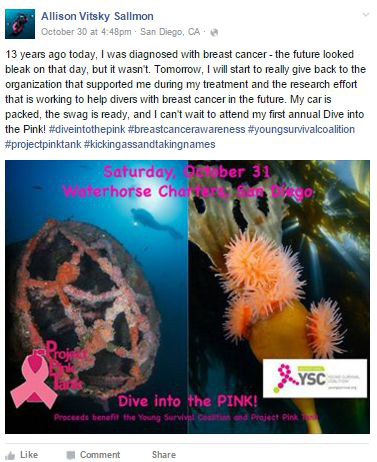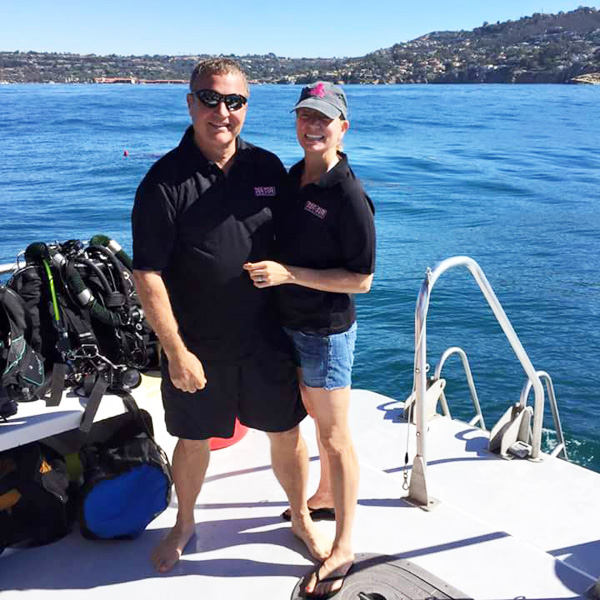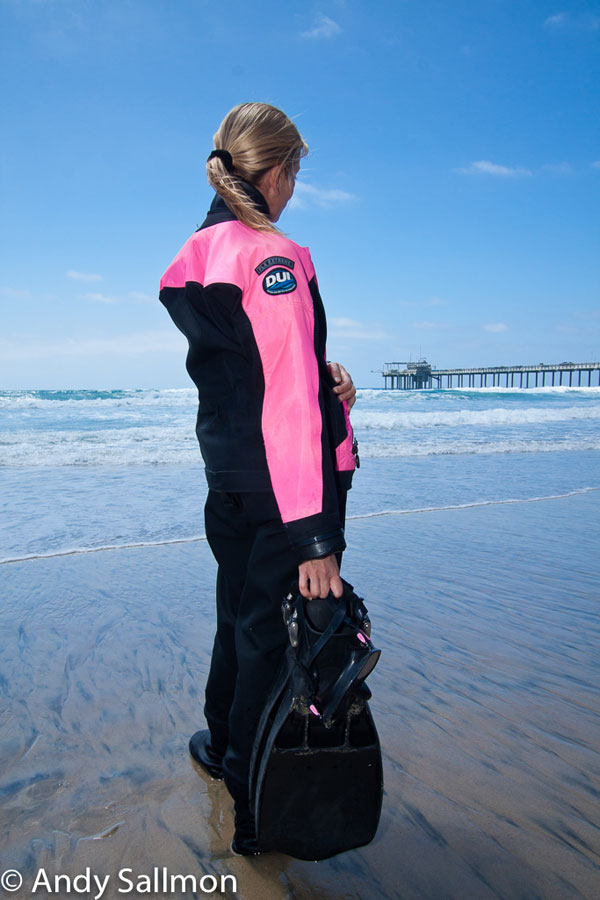The first annual DIVE INTO THE PINK was a day of celebration, compassion, friendship, costumes and diving. “Today, we raised almost $1300 for the Young Survival Coalition and Project Pink Tank – not bad for an idea hatched a month ago. It will only get better from here,” said Allison Vitsky Sallmon. Allison, a breast cancer survivor, and her husband Andy Sallmon sponsored the event which was inspired by her personal experience and flourished through a Facebook post.
Allison was diagnosed 13 years ago and wanted to, “give back to the organization that supported me the most during my treatment and the research effort that is working to help divers with breast cancer in the future.”
Breast cancer is a serious illness that along with medical treatment requires a healthy portion of positive attitude. The Humbolt dive boat, chartered with Waterhorse Charters, was loaded with 22 divers sporting pink including tutus. Quotes of the day included: “Your tutu is in the way – I can’t find your crotch strap.” “Do you ever feel like your tutu is riding up?” and “I only wear tutus on Saturday.” Participants received swag bags with Project Pink Tank hats and polo shirts from Sea & Sea with a unique pink ribbon logo.
A few days before the event, Allison also joined a fellow survivor to sign the Nancy Lee (previously the Gypsee Lee). The boat will be sunk by California Ships to Reefs (CSTR) in San Diego’s wreck alley. Allison explains, “This ship has been renamed after the beautiful survivor wife of CSTR’s own John Painter, and we were honored to meet her today. Don’t let the color fool you – breast cancer is not gentle, and it is not pretty. Survivors of this disease kicked its ass by giving up body parts, the hair on our heads, and (for some) the ability to bear children – and we are the luckiest ones, the ones who have made it. Pink is a symbol of the strongest women and men I know.”
Allison began diving in 1992 in her home state of Florida, and she quickly became obsessed with the wrecks and reefs off of the southeastern United States. Within 2 years, she was regularly immersed in the gorgeous spring-fed cave systems of central Florida. When she did her first dive in the cold waters of Gloucester, Massachusetts, she immediately fell in love with temperate water environments, and this eventually prompted her to pursue a work move to California. Her interest in photography developed more slowly, however: Allison picked up her first compact camera in 2006, and by the end of 2007, she had become addicted enough to upgrade to a dSLR. Allison’s photographic work has been recognized in numerous international underwater photography competitions and published in books and magazines on diving, marine life, and nature photography. Allison is also a gifted journalistic and creative writer, holding a Bachelor of Science degree from Boston University’s renowned College of Communications, as well as a doctorate in veterinary medicine from the University of Florida. See Allison’s photography at www.avitsky.com
Andrew Sallmon is a freelance underwater photographer and writer specializing in images and stories about marine life, scuba diving and the marine environment. Certified to dive in 1979, he became fascinated with the ocean and became a Scuba Instructor by the end of 1980. He picked up his first camera that same year and soon became hooked on underwater photography. 22 years later, his passion remains, and he is one of a fortunate few who earns a living as an underwater photographer. Andy, a California native, spends much of his time diving in and photographing the rich, temperate waters of his home state, but he also travels abroad several times each year to create new images of creatures not found in those waters. Andy’s work has been featured in numerous books, magazines and calendars, as well as in dive and underwater photographic equipment advertisements and catalogs. His photos have also been displayed in major aquariums and natural history museums throughout the US, including the Monterey Bay Aquarium and the Smithsonian Institute. See Andy’s photography at www.seait.com.
Cancer, Exercise and Diving
Scuba divers are encouraged to maintain a healthy body weight and composition to be safer in the underwater environment. Research indicates that obese divers are nine to 10 times more likely to suffer decompression sickness, use more air than aerobically fit divers, and require more effort to move through the water, compromising performance. Maintaining a healthy body composition is key to many of the correlations between physical activity and cancer prevention. Excess body fat, contributes to high levels of hormones and inflammatory proteins, which lead to high levels of insulin and cell damage; both increase cancer risk.
In addition to staying fit for scuba diving, exercise helps prevent cancer. The American Institute of Cancer Research, (AICR) “Start Where You Are” brochure of simple steps for physical activity summarizes the benefits. “Physical activity helps lower blood pressure, increase bone density, regulate cholesterol, control blood sugar, improve mood, increase brain function and improve circulation and fitness. Because of these effects, physical activity can help lower chances of cancer, heart disease, stroke, osteoporosis, diabetes, depression, dementia and arthritis.”
Maintaining the health of the heart and lungs is of particular interest to divers for continued participation in the sport, especially since cardiovascular illness and heart disease are the most prevalent medical conditions reported by divers. According to AICR, “research suggests that cancer patients who participate in a structured exercise program during chemotherapy (a practice commonly prescribed to heart patients) may reduce harmful effects of chemotherapy on the cardiovascular system, and therefore may reduce the risk of cardiovascular disease, years after treatment,” Other research also indicates that exercise during treatment may reduce the reoccurrence of cancer. Exercise during treatment is recommended at a low intensity, and depending on energy. It is recommended that divers consult with their physician about both exercise and diving during treatment.
Timing of diving after surgery and physical energy levels required for diving are of the greatest concern. Based on evidence found in Divers Alert Network (DAN) annual reports, cancer survivors who continued to scuba dive had overcome, breast, prostate, head and neck cancers. The Rubicon Foundation plans to release the results of their Project Pink study. Scuba certified breast cancer survivors provided information on their health status, diagnosis and treatment specific to diving. The study hopes to learn more about and provide information to all divers about the effects of cancer and cancer therapy on the physical and mental health of divers and diving activity.
The International Health Racquet and Sportsclub Associations (IHRSA) cites studies in their online newsletter that demonstrate the benefits of exercise in managing depression in cancer survivors. IHRSA recommends “cancer survivors could benefit from regular aerobic exercise, and may see further benefits by adding personal training or group classes to their schedule.” The research reveals a dose-response correlation; the more the cancer survivor exercises the more symptoms of depression are reduced. “There are over 12 million cancer survivors in the United States, and nearly all of them experience psychological side effects as a result of their cancer diagnosis. In addition, 60% of cancer survivors experience depressive symptoms, which are associated with reduced survival rates. A recent article reviewed 40 exercise interventions involving 2,929 cancer survivors. Results showed that participants who exercised had reduced depressive symptoms compared to those who did not. A “dose-response” relationship was found, meaning that as the amount of aerobic exercise performed each week increased, depression symptoms decreased. The greatest decreases in depressive symptoms were seen in people aged 47-62 and participants who exercised with supervision. Cancer survivors could benefit from regular aerobic exercise, and may see further benefits by adding personal training or group classes to their schedule.” Brown C, Huedo-Medina T, Pescatello L, Ryan S, Pescalto S, Moker E, LaCroix J, Ferrer R, Johnson B, The efficacy of exercise in reducing depressive symptoms among cancer survivors: a meta-analysis, PLoS One. 2012, &(1): e30955.
Source of synopsis:www.healthclubs.com newsletter V.I 11, il. 2 P1, International Health, Racquet & Sportsclub Association.



